
Material Studies
![]() The
particular climatic conditions that prevail along the central coast of
Peru allow an excellent preservation of all kinds of archaological material
(ceramic, wood, textiles, human and animal remains, plants, metals, etc.).
It is essential that the amount of material collected during each field
season be properly studied. Both Peruvian and foreign specialists have
taken charge of the analysis of the various kinds of material. These
are:
The
particular climatic conditions that prevail along the central coast of
Peru allow an excellent preservation of all kinds of archaological material
(ceramic, wood, textiles, human and animal remains, plants, metals, etc.).
It is essential that the amount of material collected during each field
season be properly studied. Both Peruvian and foreign specialists have
taken charge of the analysis of the various kinds of material. These
are:
Ceramic studies : Dr Jane Feltham (University of Liverpool) and Dr Peter Eeckhout (ULB)
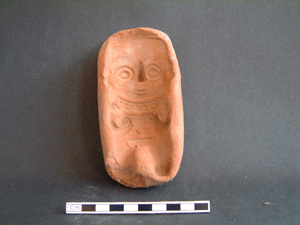
Mould for a ceramic figurine found in Pyramid n°3
(field season 2000-2001).
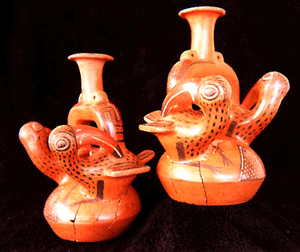
pair of stirrup-spout bottles in the local Chimu-Inca style
(field season 1999).
Anthropological studies : Dr Lawrence Owens (University of London)
Voices from the Past: The Human Remains from Pachacamac
“ While
often beautiful and fascinating in their own right, the things we tend
to think of as representing “archaeology” – be it buildings,
ceramics or textiles – can seem somewhat static, or detached from their
makers. How would you feel if your life were judged solely on the design
of your house, the contents of your trashcan, the car you drive, or
the sort of crockery you have in your kitchen? With bones, though,
you can see exactly how someone lived, what they ate, the illnesses
they suffered from, their cause of death, their biological origin and
even what their childhood was like. I think there is something incredible
about being able to peer into the lives of long-dead individuals like
this, and I always view it as a real privilege that I am able to do
so.
At the site we have thousands of loose bones and fragments that testify to the unfortunately widespread habit of grave-robbing. We have also recovered a number of intact mummies which will enable us to examine specific issues in ancient Peruvian society as well as “big questions” such as the human effects of urbanism, the evolving role of women, or the development of modern diseases. Individuals ranging from the newly born to the very old have been excavated, and we know from accompanying grave goods that all strata of society are represented, from the very poor to the extremely wealthy. The analysis is still in its infancy, but we already have a fairly good idea about what the people who lived here were like. We know that most of them died before they even reached adulthood, and that those who did usually did not live past 40 years of age. They were of compact build, with a varied diet, and seem to have enjoyed a generally healthy lifestyle. However, there was also evidence of sickness – such as syphilis, arthritis and rickets – as well as indications that some individuals had their skulls deformed in childhood, died at the hands of their fellows, or were even buried alive…” Lawrence S. Owens

mummy E-20, Temple of the Monkey
(field season 2000-2001).
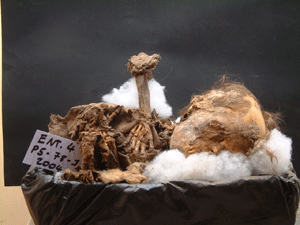
mummy of a child that was buried alive
(field season 2004)
Paleo-ichtyological studies: Dr Philippe Béarez (Museum d'Histoire Naturelle, Paris) http://www.ifeanet.org/publicaciones/articulo.php?1314
Malacological studies: Manuel Gorriti (Universidad Nacional Mayor de San Marcos, Lima) http://www.ifeanet.org/publicaciones/articulo.php?1314
Textile studies: Dr Jane Feltham (University of Liverpool)
Clothes for the living...and for the dead : the Pachacamac textiles
“ Textiles
were at the heart of ancient Peruvian society, whose members spent much
of their time spinning and weaving cloth, not only for everyday use, but
also for embellishing the wrappings of their dead. Our knowledge of their
skills comes mainly from these mummy wrappings because the dry conditions
of the Peruvian coast preserve the mummies and their grave goods. However,
it must be stated that at Pachacamac most of the graves have been looted
and their contents removed. The robbers have left behind only fragments
of the mummy wrappings, but even these are sufficient to give us some idea
of coastal and highland dress at the time of the Spanish conquest. In spite
of the looting the Ychsma Project have excavated plain cotton and camelid
wool tunics worn by men. We also have a complete woman's tunic with its
pleated front. This was possibly worn over a wrap-around skirt. We have
a cotton mantle brocaded with pelican motifs and several headbands that
depict the mythological moon animal or intertwined snakes in tapestry weave
and brilliant colours. Fragments of other mantles and wrapping cloths show
brocaded birds, fish and cat motifs, which are very common on the central
coast of Peru. Most of the cloth is cotton, and camelid fibres are only
occasionally used for brocading or in tapestry-woven headbands. We have
also discovered some fragments of early Colonial cloth, which is very interesting,
because there are few concrete examples of everyday dress after the Spanish
conquest, except for what is known from early pictures and other images.”
Jane
P. Feltham
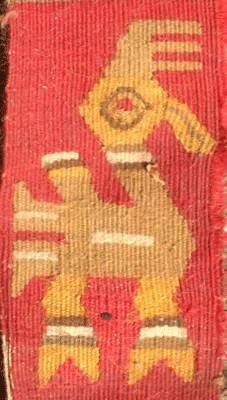
detail of a textile with a bird motif
(field campaign 2004)
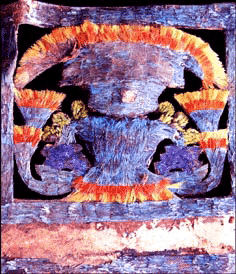
detail of a feather mosaic
headdress representing
“the decapitator” (field season 1995)
Absolute Dating : Dr Anna Pazdur and Dr Adam Michzinski (Silesian
University of Technology,Gliwice)
http://www.ingentaconnect.com/content/arizona/rdc/2003
/2003/00000045/00000001/art00009;jsessionid=e00djfhfcr5gf.victoria
Archaeobotanical studies : Dr Alexandre Chevalier (University of California, Berkeley)
Anthracological studies : Fanny Moutarde (Université Paris I)
Adobe Studies: Dimitri Ajenjo (Sainsbury Center for Visual Arts, University of Norwich, UK)
![]()